Assignment:
Multiple Choice Questions:
1. An economic is a simplified version of some aspect of economic life used to analyze an economic issue.
a. variable
b. market
c. model
d. trade-off
Scenario:
Suppose a hat manufacturer currently sells 2,000 hats per week and makes a profit of $5,000 per week. The plant owner observes, "Although the last 300 hats we produced and sold increased our revenue by $1,000 and our costs by $1,100, we are still making an overall profit of $5,000 per week so I think we're on the right track. We are producing the optimal number of hats."
2. Refer to Scenario above. Had the firm not produced and sold the last 300 hats, would its profit be higher or lower, and if so by how much?
a. Its profit will be $1,100 higher.
b. Its profit will be $1,000 lower.
c. Its profit will be $100 lower.
d. Its profit will be $100 higher.
3. The term market in economics refers to:
a. a place where money changes hands.
b. a legal institution where exchange can take place.
c. a group of buyers and sellers of a product and the arrangement by which they come together to trade.
d. an organization which sells goods and services.
Scenario:
Suppose a t-shirt manufacturer currently sells 5,000 t-shirts per week and makes a profit of
$10,000 per week. A manager at the plant observes, "Although the last 400 t-shirts we produced and sold increased our revenue by $4,000 and our costs by $4,800, we are still making an overall profit of $10,000 per week so I think we're on the right track. We are producing the optimal number of t-shirts."
4. Refer to Scenario above . Using marginal analysis terminology, what is another economic term for the incremental cost of producing the last 400 t-shirts?
a. marginal cost
b. explicit cost
c. operating cost
d. Any of the above terms are correct.
5. Suppose the U.S. government encouraged new teachers to take jobs in underperforming schools by paying the new teachers a $20,000 bonus. These teachers would be exemplifying the economic idea that:
a. people respond to economic incentives
b. people are rational
c. optimal decisions are made at the margin
d. equity is more important than efficiency
6. Dr. Goldfinger decides to invest in companies which he believes can "improve the productivity and efficiency" of health care services. How can Dr. Goldfinger strive to achieve this productive efficiency?
a. by investing in companies that produce goods and services at the lowest possible cost
b. by investing in companies that produce up to the point where the marginal benefit of the last unit produced is equal to the marginal cost of producing it.
c. by investing in companies that fairly distribute their products and services
d. by investing in companies that produce goods and services based on consumer preferences
7. How are the fundamental economic decisions determined in Canada?
a. The United Nations decides because Canada is a developing economy.
b. The government decides because Canada is a centrally planned economy.
c. Individuals, firms, and the government interact in a market to make these economic decisions.
d. These decisions are made by the country's elders who have had much experience in answering these questions.
8. Which of the following is a macroeconomics question?
a. How is the production quantity of snowboards determined?
b. What factors determine the price of electronic cigarettes?
c. What determines the growth rate of gross domestic product?
d. What determines the salaries of Wall Street executives?
9. Scarcity:
a. stems from the incompatibility between limited resources and unlimited wants
b. can be overcome by discovering new resources
c. can be eliminated by rationing products
d. is a bigger problem in market economies than in socialist economies
10. The principle of opportunity cost is that:
a. in a market economy, taking advantage of profitable opportunities involves some money cost
b. the economic cost of using a factor of production is the alternative use of that factor that is given up
c. taking advantage of investment opportunities involves costs
d. the cost of production varies depending on the opportunity for technological application
11. A production possibilities frontier with a bowed outward shape indicates:
a. the possibility of inefficient production
b. constant opportunity costs as more and more of one good is produced
c. increasing opportunity costs as more and more of one good is produced
d. decreasing opportunity costs as more and more of one good is produce
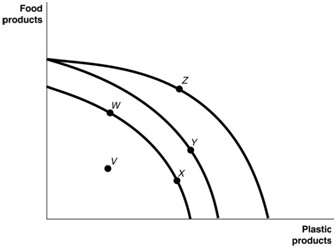
Figure shows various points on three different production possibility frontiers for a nation.
12. Refer to Figure above . Consider the following events:
(a) an increase in the unemployment rate
(b) general technological advancement
(c) decrease in consumer wealth
Which of the events listed above could cause a movement from X to V?
a. a only
b. a and b only
c. b and c only
d. a, b, and c
13. You have an absolute advantage whenever you:
a. are better educated than someone else
b. can produce something at a lower opportunity cost than others
c. prefer to do one particular activity
d. can produce more of something than others with the same resources
Table:
Production choices for Nadia's Neckware
|
Choice
|
Quantity of Ascots Produced
|
Quantity of Bowties Produced
|
|
A
|
32
|
0
|
|
B
|
24
|
6
|
|
C
|
16
|
12
|
|
D
|
8
|
18
|
|
E
|
0
|
24
|
14. Refer to Table. Assume Nadia's Neckware only produces ascots and bowties. A combination of 16 ascots and 6 bowties would appear:
a. along Nadia's production possibilities frontier
b. inside Nadia's production possibilities frontier
c. outside Nadia's production possibilities frontier
d. at the horizontal intercept of Nadia's production possibilities frontier
15. If the best surgeon in town is also the best at cleaning swimming pools, then according to economic reasoning, this person should:
a. specialize in being a surgeon because its opportunity cost is lower
b. specialize in cleaning swimming pools because it is more labor-intensive
c. split his time evenly between being a surgeon and cleaning swimming pools
d. should pursue the activity he enjoys more
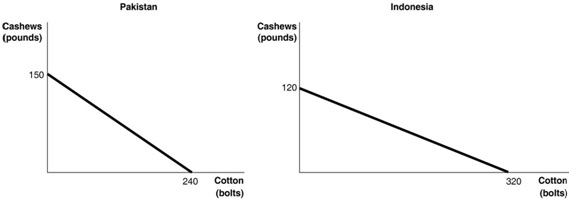
Figure shows the production possibilities frontiers for Pakistan and Indonesia. Each country produces two goods, cotton and cashews.
16. Refer to Figure above. Which country has a comparative advantage in the production of cotton?
a. Pakistan
b. They have equal production abilities.
c. Indonesia
d. neither country
17. Refer to Figure above. Which country has a comparative advantage in the production of cashews?
a. They have equal production abilities.
b. Pakistan
c. Indonesia
d. neither country
18. If a commercial dairy farm wants to raise funds to purchase feeding troughs, it does so in the
a. output market.
b. product market.
c. factor market.
d. dairy products market.
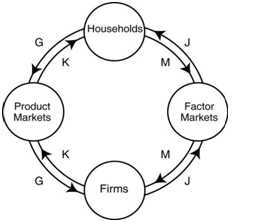
19. Refer to Figure above. Which two arrows in the diagram depict the following transaction: LaDonna sells 20 pairs of sunglasses at the Oakley store.
a. J and G
b. K and G
c. K and M
d. J and M
20. All of the following countries come close to the free market benchmark except:
a. Singapore
b. Canada
c. North Korea
d. Germany
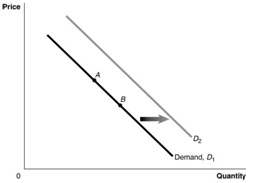
21. Refer to Figure above. An increase in the price of a substitute would be represented by a movement from
a. A to B.
b. B to A.
c. D1 to D2.
d. D2 to D1.
22. In June, buyers of titanium expect that the price of titanium will fall in July. What happens in the titanium market in June, holding everything else constant?
a. The quantity demanded decreases.
b. The demand curve shifts to the left.
c. The demand curve shifts to the right.
d. The quantity demanded increases.
23. Suppose that when the price of strawberries decreases, Simone increases her purchase of whipped cream. To Simone:
a. strawberries and whipped cream are substitutes
b. strawberries and whipped cream are normal goods
c. strawberries are a normal good and whipped cream is an inferior good
d. strawberries and whipped cream are complements
24. What is the difference between an increase in supply and an increase in quantity supplied?
a. There is no difference between the two terms; they both refer to a shift of the supply curve.
b. An increase in supply means the supply curve has shifted to the right while an increase in quantity supplied refers to a movement along a given supply curve in response to an increase in price.
c. An increase in supply means the supply curve has shifted to the right while an increase
in quantity supplied means at any given price supply has increased.
d. There is no difference between the two terms; they both refer to a movement along a given supply curve.
25. Which of the following is the correct way to describe equilibrium in a market?
a. At equilibrium, quantity demanded equals quantity supplied.
b. At equilibrium, market forces no longer apply.
c. At equilibrium, scarcity is eliminated.
d. At equilibrium, demand equals supply.
26. Assume that the price for swimming pool maintenance services has risen and sales of these services have fallen. One can conclude that:
a. the law of supply has been violated
b. the demand for swimming pool maintenance services has increased
c. the supply of swimming pool maintenance services has decreased
d. swimming pool maintenance services are becoming more technologically advanced
27. Suppose a drought resulted in a major reduction in the California lettuce crop. In the market for lettuce, the:
a. supply curve shifted to the left resulting in an increase in the equilibrium price
b. supply curve shifted to the left resulting in a decrease in the equilibrium price
c. demand curve shifted to the right resulting in an increase in the equilibrium price
d. demand curve shifted to the left resulting in a decrease in the equilibrium price
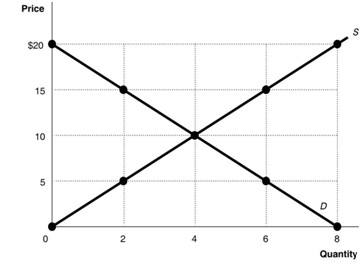
28. Refer to Figure above. At a price of $20, the quantity sold:
a. is 0 units
b. is 4 units
c. is 8 units
d. cannot be determined
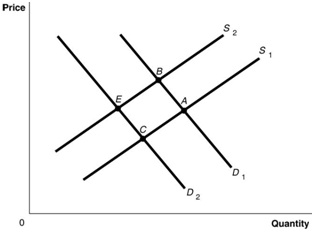
29. Refer to Figure above. The graph in this figure illustrates an initial competitive equilibrium in the market for apples at the intersection of D2 and S2 (point E). Which of the following changes would cause the equilibrium to change to point A?
a. A positive change in the technology used to produce apples and a decrease in the price of oranges (a substitute for apples)
b. An increase in the wages of apple workers and a decrease in the price of oranges (a substitute for apples)
c. An increase in the number of apple producers and a decrease in the number of apple trees as a result of disease
d. A decrease in the wages of apple workers and an increase in the price of oranges (a substitute for apples)
30. In New York City, about 1 million apartments are subject to rent control by the local government. Rent control:
a. is a government policy which limits apartment rental to those people whose incomes are less than $50,000 per year
b. only applies to those apartments which are owned and rented out by the local government
c. is a price floor which sets a minimum rent for apartments
d. puts a legal limit on the rent that landlords can charge for an apartment
|
Consumer
|
Willingness to Pay
|
|
Tom
|
$40
|
|
Dick
|
30
|
|
Harriet
|
25
|
31. Refer to Table above . The table above lists the highest prices three consumers, Tom, Dick and Harriet, are willing to pay for a short-sleeved polo shirt. If the price of the shirts falls from $28 to $20:
a. Tom will buy two shirts while Dick and Harriet will each buy one shirt.
b. consumer surplus increases from $14 to $35.
c. consumer surplus will increase from $70 to $95.
d. Harriet will receive more consumer surplus than Tom or Dick.
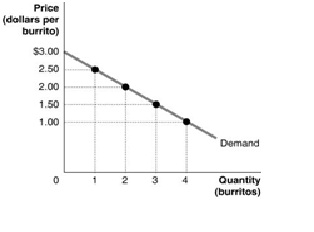
32. Refer to Figure above. What is the total amount that Arnold is willing to pay for 2 burritos?
a. $2.00
b. $4.50
c. $7.50 d. $10.00
33. Refer to Figure 4-1. If the market price is $3.00, what is the maximum number of burritos that Arnold will buy?
a. 0
b. 2
c. 3
d. 4
|
Marko's Polos
|
Marginal Cost (dollars)
|
|
1st shirt
|
$7
|
|
2nd shirt
|
10
|
|
3rd shirt
|
15
|
|
4th shirt
|
20
|
34. Refer to Table 4-6. The table above lists the marginal cost of polo shirts by Marko's, a firm that specializes in producing men's clothing. What will happen if the price of polo shirts decreases from $15 to $10?
a. there will be a shortage of polo shirts
b. the marginal cost of producing the third polo shirt will increase to $25
c. consumers will buy no polo shirts
d. producer surplus will fall from $13 to $3
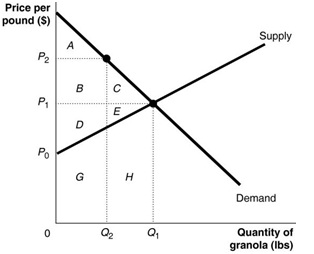
Figure shows the market for granola. The market is initially in equilibrium at a price of P1 and a quantity of Q1. Now suppose producers decide to cut output to Q2 in order to raise the price to P2.
35. Refer to Figure above. What area represents consumer surplus at the equilibrium price of P1?
a. A + B + C + D + E
b. D + E
c. A + B + C
d. A
36. The sum of consumer surplus and producer surplus is equal to:
a. total profit
b. the economic surplus
c. zero
d. the deadweight los
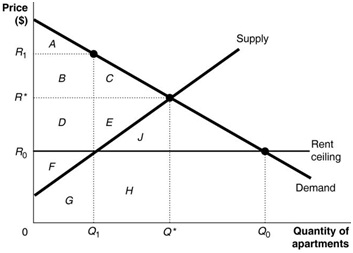
Figure shows the market for apartments in Bay City. Recently, the government imposed a rent ceiling at R0.
37. Refer to Figure above. Suppose that instead of a price ceiling, the government imposed a price floor of R . What is the area representing producer surplus after the imposition of the price floor?
a. B + D + F
b. C + E
c. A
d. B + C + D + E + F
38. Assume that production from an electric utility caused acid rain and that the government imposed a tax on the utility equal to the cost of the acid rain. This is an example of:
a. the Coase Theorem
b. a Pigovian subsidy
c. a transaction cost
d. a Pigovian tax
39. A contract under which a buyer agrees to make payments in exchange for the provider agreeing to pay some or all of the buyer's medical bills is referred to as:
a. a fee-for-service plan
b. health insurance
c. the Affordable Care Act
d. a deductible
40. In the United States in 2012, of those companies employing more than 200 workers that offer health care to those workers, about percent of employees accept the coverage.
a. 10
b. 36
c. 62
d. 98
41. Typically, the higher the level of income per person in a country, the higher the level of spending per person on health care. This relationship between income and spending indicates that health care is a:
a. necessity
b. inferior good
c. normal good
d. luxury
42. In the United States, health care spending per person based on income per person is the average for most other countries.
a. significantly lower than
b. slightly lower than
c. comparable to
d. significantly higher than
43. Of the following high-income countries, which has the highest number of CT scanners per 1 million population?
a. Canada
b. Japan
c. the United Kingdom
d. the United States
44. Consumers usually pay less than the total cost of medical treatment because:
a. the federal government pays for most medical procedures
b. competition forces doctors and hospitals to charge prices that do not cover their costs
c. a third party, usually an employer, often pays most of the bill
d. a third party, usually an insurance company, often pays most of the bill
45. Because consumers who have insurance provided by their employers usually only pay a deductible for a visit to the doctor's office:
a. they demand a larger quantity of health care services than they would if they paid a price that better represented the true cost of providing the service
b. the insurance companies provide a larger quantity of health care services than they would if the consumer paid a price that better represented the true cost of providing the service
c. they demand a smaller quantity of health care services than they would if they paid a price that better represented the true cost of providing the service
d. the doctors supply a smaller quantity of health care services than they would if the consumer paid a price that better represented the true cost of providing the service
46. Basic supply and demand analysis indicates that having firms rather than the government provide health insurance to workers:
a. changes neither the composition of the compensation that firms pay nor its level
b. does not change the composition of the compensation that firms pay, but does change its level
c. changes both the composition of the compensation that firms pay and its level
d. changes the composition of the compensation that firms pay, but does not change its level
47. Which type of businesses earns the majority of profits in the United States?
a. sole proprietorships
b. partnerships
c. corporations
d. None of the above.
48. Economists refer to the conflict between the interests of shareholders and the interests of top management as:
a. a liability problem
b. a stock-equity problem
c. a principal-agent problem
d. a financial intermediary problem
49. What takes place in the indirect finance market?
a. Part ownership of corporations is sold in the form of stocks.
b. Corporate and government bonds are sold to savers.
c. Government purchases of buildings and equipment are sold to the highest bidder.
d. Deposits of savers are accepted and loans made to borrowers.
50. Southwest Airlines wants to raise $20 million to finance the renovation of their corporate offices, and the company wishes to raise the funds through direct finance. Which of the following methods could it use?
a. It could issue $20 million in stocks.
b. It could sell $20 million in bonds.
c. It could borrow $20 million from a bank.
d. It could choose either A or B.
51. Donnie's Donuts incurs $450,000 per year in explicit costs and $200,000 in implicit costs. The bakery earns $800,000 in revenues and has $2 million in net worth. Based on this information, what is the accounting profit for Donnie's Donuts?
a. $350,000
b. $150,000
c. $600,000
d. $1.2 million
52. Jake sells Star Wars memorabilia on eBay. His annual revenue is $42,000 per year, the explicit costs of his business are $10,000, and the opportunity costs of his business are $18,000 per year. What are the implicit costs of his business?
a. $8,000 b. $18,000 c. $24,000 d. $32,000
53. When someone takes out a mortgage loan to buy a house, the mortgage lender can take possession of the house and sell it if the borrower defaults by failing to make payments on the loan because the house is being pledged as for the loan.
a. insurance
b. collateral
c. a liability
d. goodwill
54. Most people would prefer to drive a luxury car that has all the options, but more people buy less expensive cars even though they could afford the luxury car. Why?
a. The marginal utility per dollar spent on the less expensive car is higher than that spent on luxury cars.
b. Car buyers are irrational.
c. Luxury cars cost a lot more than non-luxury cars.
d. The total utility of less expensive cars is greater than that of luxury cars.
|
Quantity of Soup (cups)
|
Total Utility
|
Quantity of Sandwiches
|
Total Utility
|
|
1
|
40
|
1
|
45
|
|
2
|
60
|
2
|
75
|
|
3
|
72
|
3
|
102
|
|
4
|
82
|
4
|
120
|
|
5
|
88
|
5
|
135
|
|
6
|
90
|
6
|
145
|
Table above shows Keira's utility from soup and sandwiches. The price of soup is $2 per cup and the price of a sandwich is $3. Keira has $18 to spend on these two goods.
55. Refer to Table 7-2. What is Keira's marginal utility per dollar spent on the third cup of soup?
a. 72 units of utility
b. 36 units of utility
c. 12 units of utility
d. 6 units of utility
56. Suppose the marginal utilities for the first three cans of soda are 100, 80 and 60, respectively. What is the total utility received from consuming 2 cans of soda?
a. 20
b. 80
c. 90
d. 180
57. In order to derive an individual's demand curve for salmon, we would observe what happens to the utility-maximizing bundle when we change:
a. tastes and preferences and hold everything else constant
b. income and hold everything else constant
c. the price of the product and hold everything else constant
d. the price of a close substitute and hold everything else constant
58. In their surveys of consumers, Daniel Kahneman, Jack Knetsch and Richard Thaler found that:
a. most people considered an increase in price by firms following an increase in their costs to be fair but believed it was unfair for firms to raise their prices because of an increase in demand
b. most people considered it unfair for firms to raise their prices because of an increase in their costs, but fair to raise their prices after an increase in demand
c. most people considered any increase in price to be unfair as it led to an increase in profits
d. most people believed that low income people were hurt most by increases in prices
59. If tolls on a toll road can be raised significantly before commuters will consider using a free alternative, demand for using the toll road must be:
a. elastic
b. unit elastic
c. perfectly elastic
d. inelastic
60. Jennifer Borts moves her office from the premises she rents at a local mall to her home. What is the result of this move?
a. Jennifer's opportunity costs fall.
b. Jennifer's total costs fall.
c. Jennifer's explicit costs fall and her implicit costs rise.
d. Jennifer's implicit costs fall.
61. The rules of accounting generally require that costs be used for purposes of keeping a company's financial records and for paying taxes. These costs are sometimes called costs.
a. explicit; accounting
b. economic; legal
c. total; economic
d. real; explicit
62. Red Stone Creamery currently hires 5 workers. When it added a 6th worker, its output actually fell. Which of the following statements is true?
a. The marginal product of the sixth worker must be negative.
b. The sixth worker is not as skilled as the fifth worker.
c. The average product of the sixth worker is negative.
d. The total product becomes negative.
63. In the short run, why does a production function eventually display diminishing returns to labor?
a. As the number of workers increases it becomes difficult to monitor them.
b. As a firm hires more workers the skills and the work ethic of the additional workers will eventually decline.
c. The opportunity cost of hiring additional workers must eventually rise.
d. As the number of workers increases eventually the gains from the division of labor and specialization are used up.
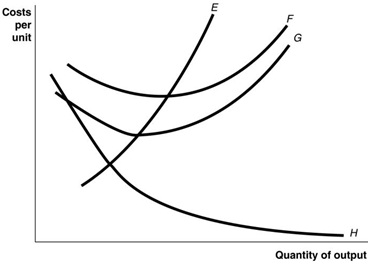
64. Refer to Figure above. Identify the curves in the diagram.
a. E = marginal cost curve; F = total cost curve; G = variable cost curve, H = average fixed cost curve
b. E = marginal cost curve; F = average total cost curve; G = average variable cost curve; H
= average fixed cost curve.
c. E = average fixed cost curve; F = variable cost curve; G = total cost curve, H = marginal cost curve
d. E = average fixed cost curve; F = average total cost curve; G = average variable cost curve, H = marginal cost curve
65. Assume that you observe the long-run average cost curve of ACME Bookstores, a national chain. Starting from the point on the curve where output is zero and moving to the right which of the following lists the behavior of long-run average costs in the correct sequence (that is, which will be observed first, second, etc.)?
a. economies of scale; minimum efficient scale; constant returns to scale; diseconomies of scale
b. economies of scale; constant returns to scale; diseconomies of scale; minimum efficient scale
c. minimum efficient scale; economies of scale; constant returns to scale; diseconomies of scale
d. constant returns to scale; economies of scale; minimum efficient scale; diseconomies of scale
66. Firms in perfectly competitive industries are unable to control the prices of the products they sell and are unable to earn a profit in the long run. Which of the following is one reason for this?
a. Firms in these industries sell identical products.
b. Owners of perfectly competitive firms realize that their short-run profits are temporary. Therefore, they either sell their businesses or develop other products that will earn short- run profits.
c. Firms in perfectly competitive industries can use advertising in the short run to persuade consumers that their products are better than those of other firms. But eventually consumers realize that all of the firms sell virtually identical products.
d. Firms from other countries are able to produce similar products at lower costs.
67. The marginal revenue curve for a perfectly competitive firm is .
a. the same as its marginal cost curve
b. the same as its demand curve
c. perfectly inelastic
d. downward-sloping
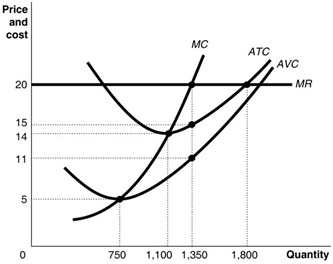
Figure shows cost and demand curves facing a typical firm in a constant-cost, perfectly competitive industry.
68. Refer to Figure above. If the firm's fixed cost increases by $1,000 due to a new environmental regulation, what happens in the diagram above?
a. Only the average total cost curve shifts upward; the marginal cost and average variable cost curves are not affected.
b. All the cost curves shift upward.
c. Only the average variable cost and average total cost curves shift upward; marginal cost is not affected.
d. None of the curves shift; only the fixed cost curve, which is not shown here, is affected.
69. What is always true at the quantity where a firm's average total cost equals average revenue?
a. The firm breaks even.
b. Marginal cost equals marginal revenue.
c. The firm's profit is maximized.
d. The firm's revenue is maximized.
70. Which of the following is not an option for a perfectly competitive firm that suffers short-run losses?
a. shutting down
b. reducing production
c. reducing the use of variable factors
d. raising price
71. Assume that the LCD and plasma television sets industry is perfectly competitive. Suppose a producer develops a successful innovation that enables it to lower its cost of production. Whathappens in the short run and in the long run?
a. Initially, the firm will be able to increase its profit significantly, but in the long run its profits will still be greater than zero but lower than its short run profits because otherfirms would also innovate.
b. The firm will be able to increase its profits temporarily, but in the long run its profits will be eliminated as other firms copy the innovation.
c. The firm will probably incur losses temporarily because of the high cost of the innovation, but in the long run it will start earning positive profits.
d. This firm will be able to earn above normal profits indefinitely if it obtains a patent for its innovation.
72. A public franchise:
a. results from ownership of a key raw material
b. is an unregulated monopoly necessary for the public good
c. is a corporation that is owned by stockholders
d. is a government designation that a private firm is the only legal producer of a good or service
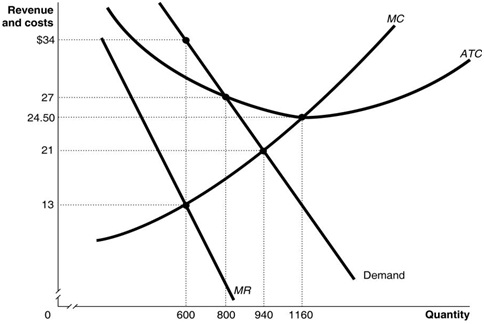
Figure shows the demand and cost curves for a monopolist.
73. Refer to Figure above. What is the economically efficient output level?
a. 600 units
b. 800 units
c. 940 units
d. 1160 units
74. Market power refers to the ability of .
a. a firm to charge a price higher than the marginal cost of production
b. consumers to dictate what products should be produced
c. firm to advertise its product and succeed in selling more output
d. a firm to sell at a lower price than rival sellers
75. The size of a deadweight loss in a market is reduced by:
a. market price being close to marginal cost
b. creative destruction
c. government legislating a ceiling price
d. government legislating a price floor
76. Natural monopolies in the United States are generally regulated by:
a. the Department of Commerce
b. local or state regulatory commissions
c. the Federal Trade Commission
d. the Department of Justice
77. The reason that the coffeehouse market is monopolistically competitive rather than perfectly competitive is because:
a. products are differentiated
b. barriers to entry are very low
c. entry into the market is blocked
d. there are many firms in the market
|
Quantity Sold
|
Price
|
Total Revenue
|
Marginal Revenue
|
Total Cost
|
Marginal Cost
|
Profit
|
|
0
|
$10
|
$0
|
-----
|
$2
|
-----
|
-$2
|
|
1
|
9
|
9
|
|
8
|
|
|
|
2
|
8
|
16
|
|
13
|
|
|
|
3
|
7
|
21
|
|
17
|
|
|
|
4
|
6
|
24
|
|
20
|
|
|
|
5
|
5
|
25
|
|
22
|
|
|
|
6
|
4
|
24
|
|
26
|
|
|
Table lists estimated revenues and costs (per week) for plastic vials (100 vials per box) for the Victoria Biological Supplies Company. Victoria sells plastic vials to university and private research laboratories.
78. Refer to Table above. Victoria's profit-maximizing quantity sold (Q) and price (P) are:
a. Q = 3; P = $7
b. Q = 5; P = $5
c. Q = 6; P = $4
d. Q = 4; P = $6
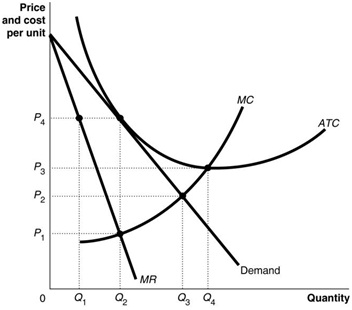
79. Refer to Figure above. What is the amount of excess capacity?
a. Q4 - Q3 units
b. Q3 - Q2 units
c. Q3 - Q1 units
d. Q4 - Q2 units
80. In both monopolistically competitive and perfectly competitive industries:
a. there are many buyers and sellers
b. firms are price takers
c. there are high barriers to entry
d. firms produce products for which there are no close substitutes
Table:
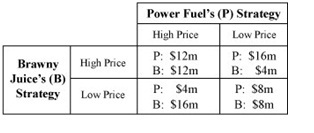
Two rival oligopolists in the athletic supplements industry, Power Fuel Company and Brawny Juice Company, have to decide on their pricing strategy. Each can choose either a high price or a low price. Table shows the payoff matrix with the profits that each firm can expect to earn depending on the pricing strategy it adopts.
81. Refer to Table above. If the firms cooperate, what prices will they select?
a. Both firms will select a low price.
b. Brawny Juice will select a low price, Power Fuel a high price.
c. Both firms will select a high price.
d. Brawny Juice will select a high price, Power Fuel a low price.
82. An example of a final good would be:
a. the coffee beans sold to Starbucks
b. a soy latte sold by Starbucks to a student
c. the whipped cream sold to Starbucks
d. the soy milk sold to Starbucks
83. Between 2013 and 2014, if an economy's exports rise by $8 billion and its imports fall by $8 billion, by how much will GDP change between the two years, all else equal?
a. Net exports will decrease GDP by $8 billion.
b. Net exports will increase GDP by $8 billion.
c. The increase in exports is offset by the decrease in imports, so there is no change in net exports and no effect on GDP.
d. Net exports will increase GDP by $16 billion.
84. To examine how the total production of an economy has changed over time, it would be better to examine:
a. the GDP deflator
b. nominal GDP
c. real GDP
d. GDP at current prices
85. Real GDP will increase:
a. if either the price level rises or the quantity of final goods and services produced rises
b. only if the price level falls
c. only if the quantity of final goods and services produced rises
d. only if the price level rises
86. To make the calculation of real GDP more accurate, in 1996 the BEA switched to using:
a. base-year prices
b. current prices
c. chain-weighted prices
d. market prices
87. Which of the following price indices comes closest to measuring the cost of living of the typical household?
a. GDP deflator
b. consumer price index
c. producer price index
d. household price index
88. Most economists believe that the biases in the consumer price index cause the CPI to overstate the true inflation rate by about percentage point(s).
a. one to two
b. one and one-half
c. one quarter
d. one-half to one
|
Year
|
Nominal Average Hourly Earnings
|
CPI
(1982-1984 =100)
|
|
2011
|
$10
|
100
|
|
2012
|
10
|
105
|
|
2013
|
12
|
110
|
89. Refer to Table above. Looking at the table above, real wages from 2011 to 2012, and real wages from 2012 to 2013.
a. rose; fell
b. fell; rose
c. fell; fell
d. rose; rose
90. You lend $5,000 to a friend for one year at a nominal interest rate of 10%. Inflation during that year is 5%. As a result, you will receive at the end of the year, but that money has a purchasing power of .
a. $5,050; $5,025
b. $5,100; $5,050
c. $6,000; $5,500
d. $5,500; $5,250
91. If inflation is completely anticipated, .
a. lenders lose in the economy
b. firms lose because they incur menu costs
c. borrowers lose in the economy
d. no one loses in the economy
Article Summary:
According to the Office for National Statistics in the United Kingdom, productivity in the UK in 2012 was well below the average of the G7 countries, only faring better than Japan. The G7 is a group of the seven most industrialized countries, and includes Canada, France, Germany, Italy, Japan, the United Kingdom, and the United States. Compared to the G7 average, the UK was 16% less productive per hour worked, and output was 19% worse when measured on a per worker basis. The productivity gap was the largest for the UK since 1994. Worker productivity has increased in all of the G7 nations except for the UK since 2007, where it has fallen by two percentage points. The most productive workers were in the United States, where workers were 29 percentage points more productive per hour worked than in the UK.
Source: "UK workers much less productive than others in the G7," Guardian, September 18, 2013.
92. Refer to the Article Summary. Unlike in the UK, labor productivity in the other G7 nations has increased since 2007. An increase in labor productivity:
a. allows the average consumer to increase consumption
b. will create short-run, but not long-run, economic growth
c. will increase output and decrease wages in the long run
d. will increase the labor force participation rate
93. Actual real GDP will be above potential GDP if:
a. firms are producing below capacity
b. inflation is rising
c. firms are producing at capacity
d. firms are producing above capacity
94. Labor productivity will increase if the quantity of increases and .
a. capital per hour worked; technology improves
b. labor per unit of capital; immigration increases while capital is fixed
c. capital per hour worked; immigration increases while capital is fixed
d. labor per unit of capital; technology improves
95. An increase in government purchases, ceteris paribus, will:
a. increase the supply of loanable funds
b. increase public saving
c. reduce real GDP
d. reduce investment
96. Purchases of which of the following goods would be dramatically reduced during a recession?
a. gasoline
b. ink pens
c. tomatoes
d. refrigerators
97. Changes in the price level:
a. decrease the level of aggregate supply in the long run
b. increase the level of aggregate supply in the long run only at very high levels of output
c. do not affect the level of aggregate supply in the long run
d. increase the level of aggregate supply in the long run
98. Workers and firms both expect that prices will be 3% higher next year than they are this year. As a result, .
a. workers will be willing to take lower wages next year
b. the short-run aggregate supply curve will shift to the left as wages increase
c. the purchasing power of wages will rise if wages increase by 3%
d. aggregate demand will increase by 3%
99. Why does the short-run aggregate supply curve shift to the right in the long run, following a decrease in aggregate demand?
a. Workers and firms adjust their expectations of wages and prices upward and they accept lower wages and prices.
b. Workers and firms adjust their expectations of wages and prices downward and they accept lower wages and prices.
c. Workers and firms adjust their expectations of wages and prices downward and they push for higher wages and prices.
d. Workers and firms adjust their expectations of wages and prices upward and they push for higher wages and prices.
100. When people became less concerned with the underlying value of their houses and instead focused on the expectations of the prices of their houses increasing, occurred.
a. stagflation
b. an automatic destabilizer
c. a housing bubble
d. a supply shock